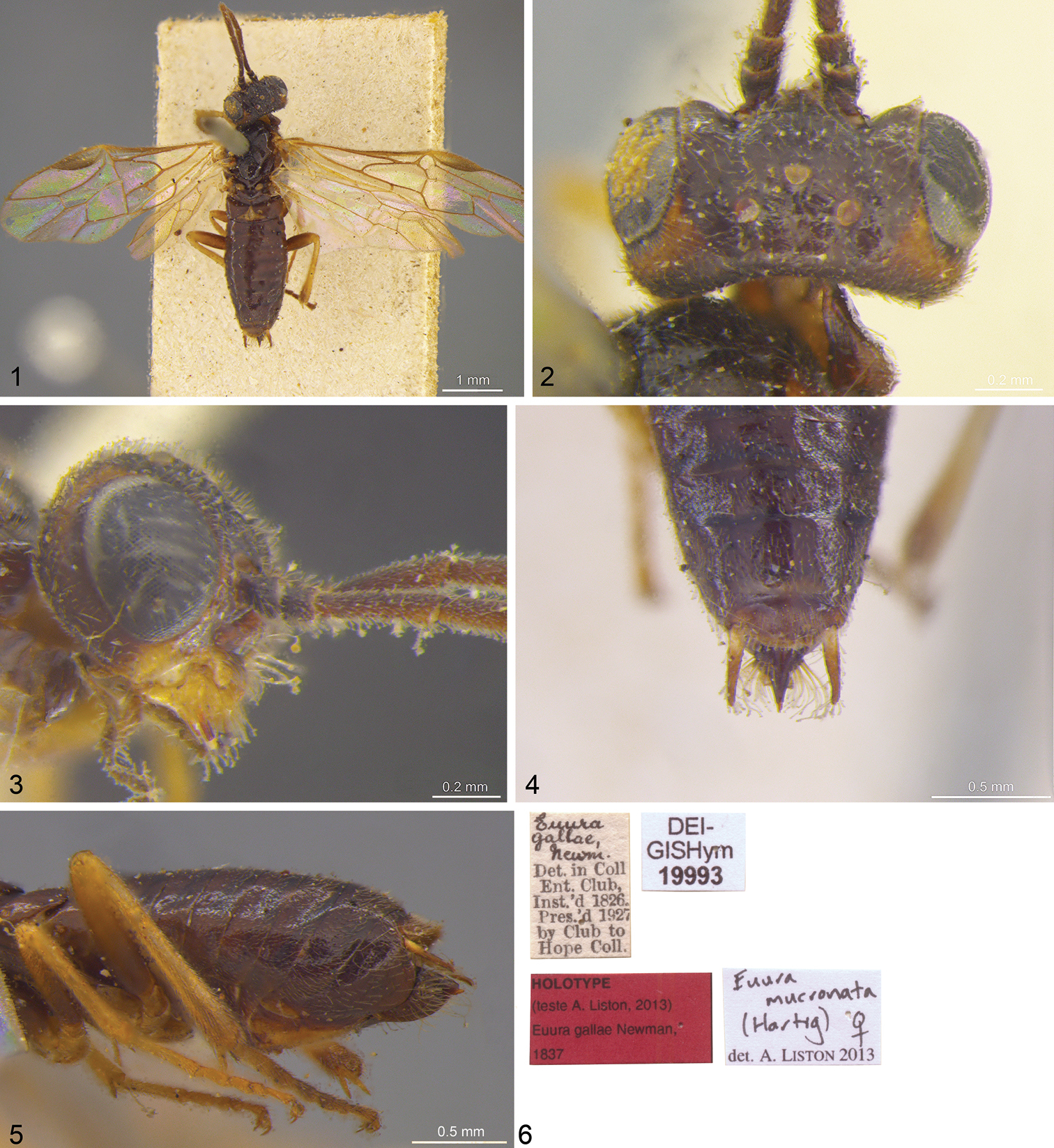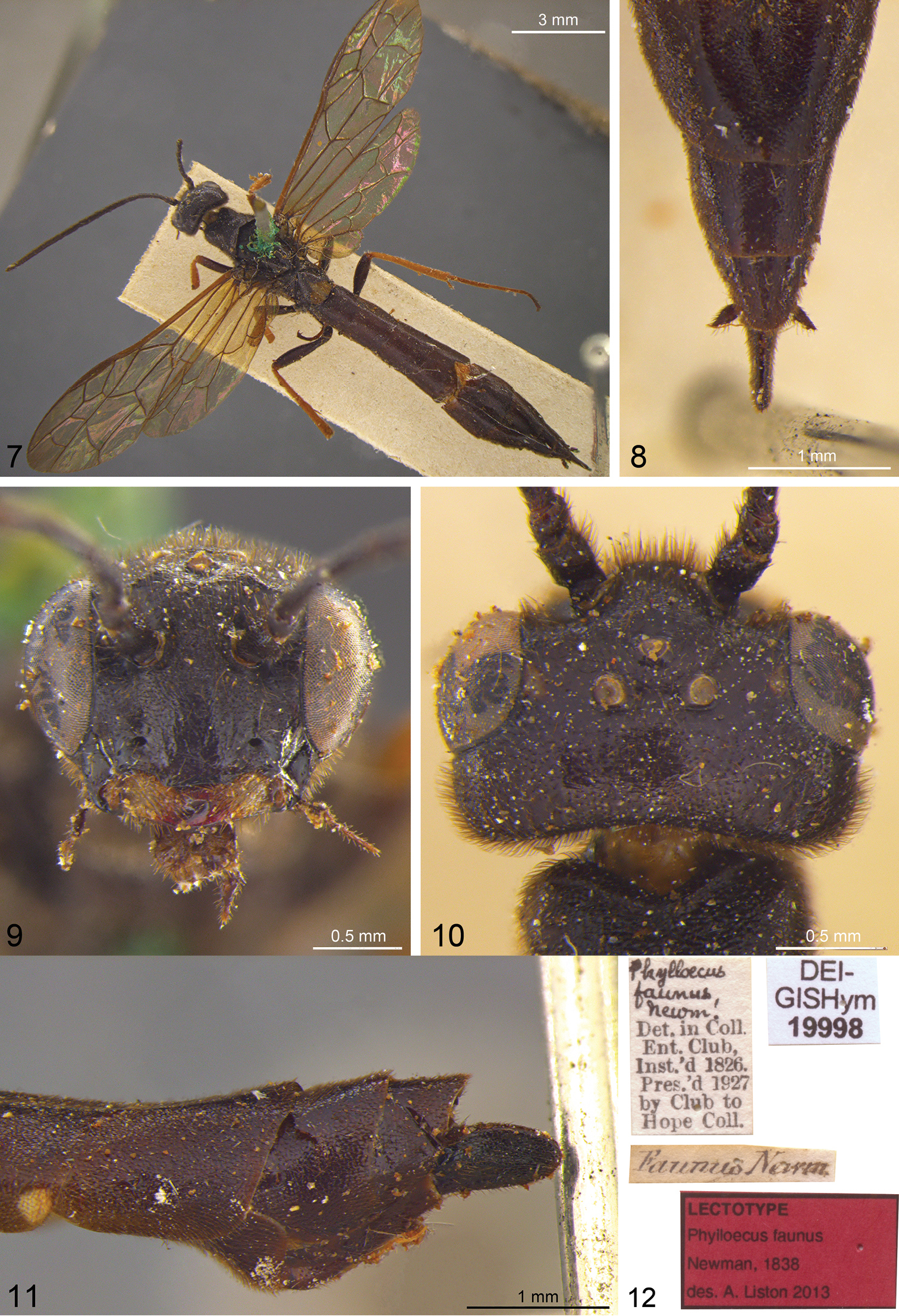






Citation: Liston AD, Prous M (2014) Sawfly taxa (Hymenoptera, Symphyta) described by Edward Newman and Charles Healy. ZooKeys 398: 83–98. doi: 10.3897/zookeys.398.6595
Type specimens of seven nominal species of sawfly described by Edward Newman and one by Charles Healy were studied. This material is housed in the Oxford University Museum of Natural History, United Kingdom. The following new synonymies are proposed (valid names in parentheses): Hartigia Schiødte, 1839 (Phylloecus Newman, 1838), Cephus helleri Taschenberg, 1871 (Phylloecus faunus Newman, 1838) and Euura gallae Newman, 1837 (Euura mucronata (Hartig, 1837)). The type species of Euura Newman, 1837 and Euura subgenus Gemmura E. L. Smith, 1968 belong to the same taxonomic species, Euura mucronata (Hartig, 1837), so that these genus group names become new synonyms. Lectotypes are designated for Phyllotoma tormentillae Healy, 1868, Fenusa ianthe Newman, 1837, Fenusa parviceps Newman, 1837, Selandria pallida Newman, 1837 and Phylloecus faunus Newman, 1838. 26 new combinations are proposed for species formerly placed in Hartigia and here transferred to Phylloecus, and 4 original combinations are re-instated as valid.
Taxonomy, Tenthredinidae, Cephidae, Euura, Phylloecus, Hartigia, new synonyms, new combinations
Edward Newman (1801–1876) described 24 species-group and six genus-group sawfly taxa as new to science. In many cases, the type material of these nominal taxa has apparently never been re-examined. During ongoing studies on West Palaearctic nematine sawflies (see
In his introduction,
All specimens mentioned in this paper are deposited in the Hope Collections, Oxford University Museum of Natural History, Oxford, United Kingdom. They are all mounted in a similar way (Figs 1, 7): pinned along the dorso-ventral axis through the thorax with a short, headless pin which is carried on a small cardboard stage supported by a longer pin with a head. When the specimens were received for examination, nearly all had only a single label, with an identical printed, lower part (Figs 6, 12). At the top of this label appears the handwritten name under which the specimens stood in the collection of the Entomological Club. Although these labels are not original, they are interpreted here as representing determinations made by Newman. None of the specimens bears any data on collection locality or date on the labels or cardboard stage.
Euura gallae Newman, 1837; holotype 1 dorsal 2 head, dorsal 3 head, lateral 4 abdomen, dorsoapical 5 abdomen, lateral 6 labels.
Phylloecus faunus Newman, 1838; lectotype. 7 dorsal 8 abdomen, dorsoapical 9 head, frontal 10 head, dorsal 11 abdomen, lateroapical 12 labels.
Taxa are listed in alphabetical order, under their current valid names. Complete lists of all the synonyms of species mentioned below and references to their original descriptions may be found in
http://species-id.net/wiki/Euura_mucronata
Euura gallae. Holotype ♀, figs 1–6: “[handwritten] Euura gallae Newm. [printed] Det. in Coll. Ent. Club, Inst.’d 1826. Pres’d 1927 by Club to Hope Coll.”, “[red] Holotype (teste A. Liston, 2013) Euura gallae Newman, 1837”, “Euura mucronata (Hartig, 1837) det. Liston 2013”, “DEI-GISHym 19993”. Condition: apical three flagellomeres of both antennae and right rear tarsus missing.
Newman’s very short original description of Euura gallae, based on a single specimen [holotype], is impossible to identify as belonging to one of the currently recognised species. The description reads: “Euura gallae. Nigra: antennis nigris, apice ferrugineis: pedibus pallidis. Black: mouth yellow; antennæ rust-coloured at the tip; the legs entirely pale. The insect is the size of Nematus pallipes: the only specimen I have observed was taken by Mr. Walker, in Scotland.”
Five specimens bearing the name Euura gallae, all females, were found in the Hope Collections. Four of these belong to the Euura atra species group. They have nearly completely dark mouthparts, except for the labrum, and the femora are conspicuously black basally. They therefore do not agree with the description of the holotype. The fifth specimen (Figs 1–6) has more extensively pale mouthparts and antennae, the malar area is conspicuously pale, and the legs are almost completely pale. This specimen is identified as the holotype of Euura gallae.
Newman’s description of Euura gallae pre-dates Hartig’s of Nematus mucronatus by a couple of months. Article 23.9 of the International Code of Zoological Nomenclature is here applied, to reverse the precedence of the species names, because the name Euura gallae (nomen oblitum) has not been used as valid after 1899, and Euura mucronata (Nematus mucronatus: nomen protectum) has been used as a valid species name in [very many] more than 25 works published by more than 10 authors in the last 50 years. A list of these references is available from us on request.
The type species of Euura Newman, 1837 by subsequent designation of
http://species-id.net/wiki/Fenella_nigrita
Phyllotoma tormentillae. Lectotype (hereby designated) ♀ [adult]: “[handwritten] Phyllotoma tormentillae, N. [printed] Det. in Coll. Ent. Club, Inst.’d 1826. Pres’d 1927 by Club to Hope Coll.”; “[red] Lectotype Phyllotoma tormentillae Healy, 1868 des. A. Liston 2013”; “Fenella nigrita Westwood, 1839 det. A. Liston 2013”, “DEI-GISHym 19994”. Condition: fair. Paralectotypes: 11♀ with same original labels, [blue] paralectotype labels, and “Fenella nigrita Westwood, 1839 det. A. Liston 2013”. One paralectotype has a large handwritten label reading “Phyllotoma Tormentillae N A complete life history of this species by Mr Healy appears in the Entomologist Vol iv p140”.
It is considered that the lectotype of Phyllotoma tormentillae [adult] was reared from the larvae described by Healy. The synonymy of Phyllotoma tormentillae with Fenella nigrita as given by
http://species-id.net/wiki/Harpiphorus_lepidus
Fenusa ianthe. Lectotype (hereby designated) ♀:”[handwritten] Phyllotoma”; “[handwritten] P. ianthe, Newm [printed] Det. in Coll. Ent. Club, Inst.’d 1826. Pres’d 1927 by Club to Hope Coll.”; “[red] Lectotype Fenusa ianthe Newman, 1837 des. A. Liston 2013”; “Harpiphorus lepidus (Klug, 1818) det. A. Liston 2013”, “DEI-GISHym 19995”. Condition: fair, but apical tarsomeres of all legs missing.
Although the sex of the type specimen[s] is not explicitly mentioned by Newman, the described colour pattern is found only in the female of this species. The comment “This insect appears generally distributed[..]” leads one to suppose that the description is based on more than one specimen. However,
http://species-id.net/wiki/Heterarthrus_nemoratus
Fenusa parviceps. Lectotype (hereby designated) ♀:”[handwritten] Druida parviceps, Newm [printed] Det. in Coll. Ent. Club, Inst.’d 1826. Pres’d 1927 by Club to Hope Coll.”; “[red] Lectotype Fenusa parviceps Newman, 1837 des. A. Liston 2013”; “Heterarthrus nemoratus (Fallén, 1808) det. A. Liston 2013”, “DEI-GISHym 19996”. Condition: fair. Paralectotypes: 2♀ and 1 cocoon-disc with same original labels, [blue] paralectotype labels, and “Heterarthrus nemoratus (Fallén, 1808) det. A. Liston 2013”.
The synonymy of Fenusa parviceps with Heterarthrus nemoratus as proposed by
http://species-id.net/wiki/Hoplocampa_alpina
Selandria pallida. Lectotype (hereby designated) ♀:”[handwritten] Hoplocampa pallida, Steph. [printed] Det. in Coll. Ent. Club, Inst.’d 1826. Pres’d 1927 by Club to Hope Coll.”; “[red] Lectotype Selandria pallida Newman, 1837 des. A. Liston 2013”; “Hoplocampa alpina (Zetterstedt, 1838) det. A. Liston 2013”, “DEI-GISHym 19997”. Condition: fair. Paralectotype: 1♂ with same original label, [blue] paralectotype label, and “Hoplocampa alpina (Zetterstedt, 1838) det. A. Liston 2013”.
Within Hoplocampa, Selandria pallida Newman is a junior secondary homonym of Tenthredo pallida Serville, 1823 (= Hoplocampa flava (Linnaeus, 1760):
http://species-id.net/wiki/Phylloecus
Phylloecus faunus was stated by
Phylloecus agilis (F. Smith, 1874), comb. n. (Cephus agilis)
Phylloecus albotegularis (Wei & Nie, 1996), comb. n. (Hartigia albotegularis)
Phylloecus algiricus André, 1881 comb. rev.
Phylloecus bicinctus Provancher, 1875 comb. rev.
Phylloecus cheni (Wei & Nie, 1999), comb. n. (Hartigia cheni)
Phylloecus coreanus (Takeuchi, 1938), comb. n. (Hartigia coreana)
Phylloecus cowichanus (Ries, 1937), comb. n. (Hartigia cowichana)
Phylloecus elevatus (Maa, 1944), comb. n. (Hartigia elevata)
Phylloecus epigonus (Zhelochovtsev, 1961), comb. n. (Hartigia epigona)
Phylloecus etorofensis (Takeuchi, 1955), comb. n. (Hartigia etorofensis)
Phylloecus fasciatus (Cresson, 1880), comb. n. (Cephus fasciatus)
Phylloecus faunus Newman, 1838, comb. rev.
Phylloecus kamijoi (Shinohara, 1999), comb. n. (Hartigia kamijoi)
Phylloecus linearis (Schrank, 1781), comb. n. (Tenthredo linearis)
Phylloecus mexicanus (Guerin, [1844]), comb. n. (Cephus mexicanus)
Phylloecus minutus (Wei & Nie, 1997), comb. n. (Hartigia minuta)
Phylloecus niger (M. Harris, [1779]), comb. n. (Sirex niger)
Phylloecus nigratus (Dovnar-Zapolskij, 1931), comb. n. (Pachycephus nigratus)
Phylloecus nigritus (Forsius, 1918), comb. n. (Macrocephus nigritus)
Phylloecus nigrotibialis (Wei & Nie, 1977), comb. n. (Hartigia nigrotibialis)
Phylloecus pyrrha (Zhelochovtsev, 1968), comb. n. (Hartigia pyrrha) [Zhelochovtsev gives no etymology for this species name. It is here considered to be a noun, the name of a figure in Greek mythology]
Phylloecus riesi (D. R. Smith, 1986), comb. n. (Hartigia riesi)
Phylloecus sibiricola Jakovlev, 1891 comb. rev.
Phylloecus simulator (Kokujev, 1910), comb. n. (Macrocephus simulator)
Phylloecus stackelbergi (Gussakovskij, 1945), comb. n. (Hissarocephus stackelbergi)
Phylloecus stigmaticalis (Wei & Nie, 1996), comb. n. (Hartigia stigmaticalis)
Phylloecus trimaculatus (Say, 1824), comb. n. (Cephus trimaculatus)
Phylloecus viator (F. Smith, 1874), comb. n. (Cephus viator)
Phylloecus xanthostoma (Eversmann, 1847), comb. n. (Cephus xanthostoma)
Phylloecus zhengi (Wei & Nie, 1996), comb. n. (Hartigia zhengi)
http://species-id.net/wiki/Phylloecus_faunus
Phylloecus faunus. Lectotype (hereby designated) ♀, Figs 7–12. “[handwritten] Phylloecus faunus, Newm. [printed] Det. in Coll. Ent. Club, Inst.’d 1826. Pres’d 1927 by Club to Hope Coll.”; “[handwritten] Faunus Newm.”; “[red] Lectotype Phylloecus faunus Newman, 1838 des. A. Liston 2013”; “Hartigia faunus (Newman, 1838) det. A. Liston 2013”. Condition: missing most of right antennal flagellum, most tarsi except right middle and rear; abdomen after tergum 5 glued to specimen.
[see also under Phylloecus, above]. Newman refers to a syntype series of three specimens of Phylloecus faunus: “Two specimens of this insect have been taken by Mr. Ingall, and one by Mr. Stephens”. The single specimen examined agrees well with the brief description. Most taxonomic works and catalogues (e.g.
Although the name faunus has not to the best of our knowledge been used as valid after 1899, neither has the name helleri been sufficiently used (in 21 publications by 27 authors including co-authors) as valid in the last fifty years to satisfy the conditions of Article 23.9 (reversal of precedence) of the International Code of Zoological Nomenclature (
Amongst the specimens borrowed for examination were also the following Tenthredinidae, apparently identified by Newman. None of these specimens is considered to be a type.
1♂ Euura atra (Jurine, 1807), det. A. Liston, with handwritten superscript on the printed label “Euura cynips, Newm.” and the following additional labels: “[printed] 1 Cynips Newm.”, “[handwritten / blue paper] Euura roboris Newman”. Remarks: The colouration of this specimen (completely black antennae, femora basally black) does not fit
1♀ Heterarthrus ochropoda (Klug, 1818), det. A. Liston, with handwritten superscript on the printed label “Druida populi”. Remarks: No publication has been located in which the name “Druida populi” is used.
2♀ Pontania proxima (Serville, 1823), det. A. Liston, with handwritten superscript on the printed label “Euura roboris, Newm.” Remarks: No publication has been located in which the name “Euura roboris” is used.
Funding and support by the Swedish Taxonomy Initiative made this work possible. We are particularly indebted to Dr James E. Hogan for the loan of material from the Hope Collections, Oxford University Museum of Natural History, and for information about the history of the Entomological Club collection. Dr Hege Vårdal, Naturhistoriska riksmuseet, Stockholm, drew attention to the paper by Greve. Dr David R. Smith, United States National Museum, Washington DC, kindly commented on a draft of the manuscript and on the use of the names Phylloecus and Hartigia. Dr Andreas Taeger, Müncheberg, initiated the loan of material from Oxford and together with Dr Stephan Blank, offered advice on the presentation of the results.

